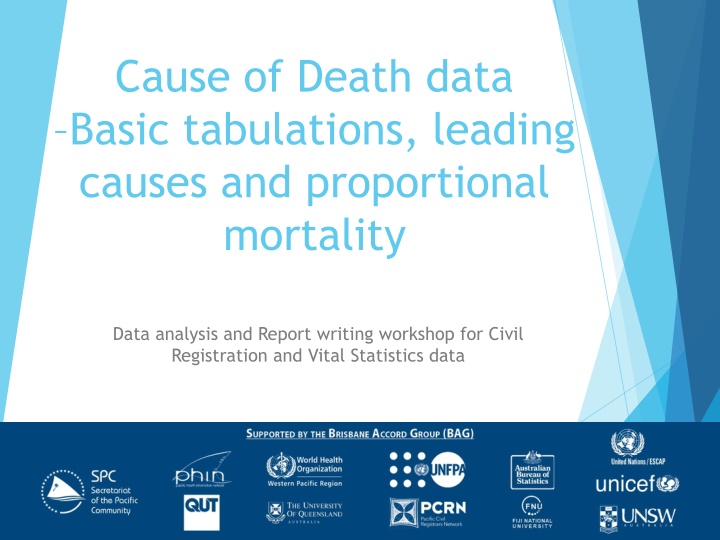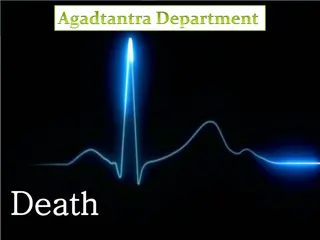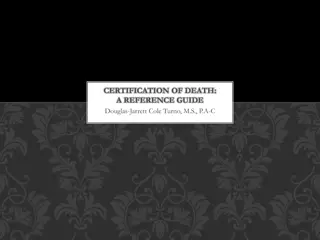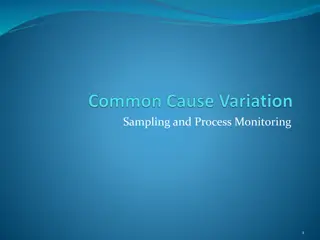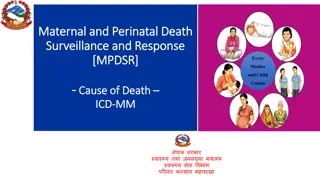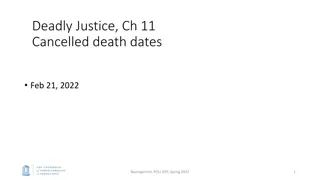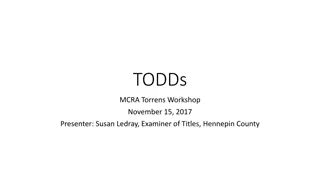Cause of Death Data Analysis Workshop
Dive into the process of analyzing cause of death data through tabulations and leading causes to generate insightful reports. Understand the creation of new variables, classification of deaths, and principles for generating meaningful tables. Explore examples and guidelines for accurate data interpretation and reporting.
Download Presentation

Please find below an Image/Link to download the presentation.
The content on the website is provided AS IS for your information and personal use only. It may not be sold, licensed, or shared on other websites without obtaining consent from the author.If you encounter any issues during the download, it is possible that the publisher has removed the file from their server.
You are allowed to download the files provided on this website for personal or commercial use, subject to the condition that they are used lawfully. All files are the property of their respective owners.
The content on the website is provided AS IS for your information and personal use only. It may not be sold, licensed, or shared on other websites without obtaining consent from the author.
E N D
Presentation Transcript
Cause of Death data Basic tabulations, leading causes and proportional mortality Data analysis and Report writing workshop for Civil Registration and Vital Statistics data
1. Basic tabulations - CoD When we re satisfied with the data quality, we are getting closer to generating our CoD tables But first we need to create new variables in our spreadsheets UCoD by the General Mortality List codes UCoD by Natural vs non-natural deaths
1. General Mortality List 1 Used after UCoD has been found via full ICD 10 list Contains 104 possible codes (rather than >14,000) Useful where total number of deaths are low Each code fits into broader category Needed for pivot tables General Mortality List available on pp. 202 of course workbook
1. Natural vs Non-natural In the ICD 10 Natural deaths include UCoDs from codes A00 to R99 Non-natural or external cause UCoDs fro codes V01-Y98 Codes in your spreadsheet will have put into Natural death or Non-natural death categories under a new variable column
1. Basic tabulations - CoD There are many types of tables we could create, but we now want to start with the most basic three 1. CoD by all ages and both sexes 2. CoD by natural causes vs external causes 3. CoD by all ages by males and females
1. Basic tabulations - CoD And there are some major table principles to help us along the way: Ensure totals are in all tables Present from highest counts to lowest counts Use specific CoD lists (e.g., General Mort List) Report deaths for which UCoD was ill-defined (R codes) Remember to aggregate over at least several years (5 is best) Include raw counts and percentages
Good example of basic tabulation CoD by ages with sex combined Source: Tuvalu CRVS Report 2012-2016 pp.14, Central Statistics Division
2. Leading causes Once we complete our basic tables, what comes next? There are many ways to look at the distribution of CoD in a population Common measures include: Leading causes Cause specific rates (age-specific, age-standardised) Probability of dying by cause Non-communicable diseases in adults Other as dictated by country-specific health priorities
2. Leading causes of death what is it? But the one we are most interested in is leading causes of death... Most basically it is the ranking of different causes of death in a population from the highest to the lowest Usually includes the top ten causes of death Leading causes can then be split into different groups (e.g., men and women, regional areas, age groups)
2. Leading causes of death One of the most common approach to reporting CoD Commonly requested and sought after by policy makers, government decision makers and international bodies Easier to understand & construct than many other indicators and rates Can be visualised in various ways
2. Leading causes of death some disadvantages Doesn t tell the whole story Rare diseases, uncommon but serious causes of death can be overlooked Not as meaningful when deaths are grouped across all ages and both sexes The top five deaths in this table are non-communicable, and don t necessarily reflect a major health problem. Without age groups included, we cannot tell whether these causes are contributing to premature mortality or not.
2. Leading cause of death tabulations There are many different ways to produce leading cause tables, but for this session we want to start with the most basic Leading causes by four subgroups - because CoD vary by age and sex, It is more meaningful to use the following groups: 0-4 years - combined sexes (Early Childhood) 5-14 years - combined sexes (Late Childhood) 15-59 years by male and female (Adults) 60+ years - by male and female (Older Adults) By region, ethnicity, and others as needed by your country Note: these are new age variables and will need to be created in the practical session
2. Leading cause of death tabulations - Basic tabulation rules apply Ensure totals are in all tables Present causes from highest to lowest Report proportion of deaths for which CoD was ill-defined Tabulate by UCoD Use percentages/proportions alongside raw counts
2. Examples of leading causes tables Adults The third sub group is causes of death in adults age 15-59 years by male and female (reported separately) Source: Tuvalu CRVS Report 2012-2016, Central Statistics Division
2. Examples of multiple leading causes tables ABS example
2. Leading causes not all there is! Leading cause tabulations are a good starting point But other types of tabulations may be needed to meet user needs across government, academics/researchers and international organisations
Practical Session tasks Create three new variable columns 1. UCoD by General Mort List (pp. 202 of workbook) 2. UCoD either Natural or Non-Natural (remember UCoDs from A00 to R99 are Natural ) 3. New ages for leading causes 0-4, 5-14, 15-59, 60+ Create three basic tabulations 1. UCoD by all ages and both sexes 2. UCoD by natural causes vs non-natural causes 3. UCoD by all ages by males and females Create four leading cause tabulations (and more if required) 1. 0-4 years and 5-14 years - sexes combined 2. 15-59 years and 60+ years - by males and females 3. By region, ethnicity and others as needed by your country
